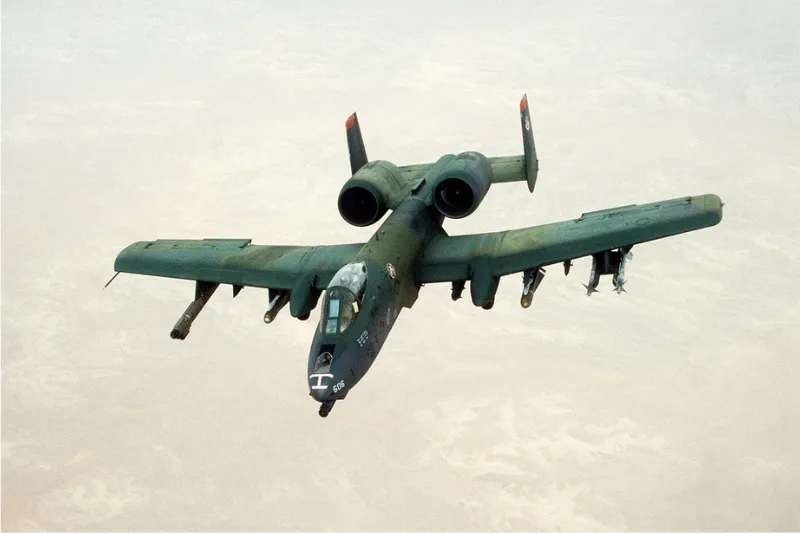2-SECOND BURSTS
SHORT THOUGHTS ON LEADERSHIP, DECISION-MAKING, FLIGHT, AND OTHER TOPICS OF THE DAY
ARTICLES

Why Hate the A-10?
Since Tail 82-665 (last A-10 manufactured) rolled off the assembly line from Bethpage, NY in 1983, an army of Air Force fighter pilot haters have vied for the retirement of an aircraft that was purpose built around its 30-mm cannon to support ground forces. The original name--Thunderbolt II--was soon eclipsed by the derogatory term "warthog" because of the warts that double as engine cowlings. Ugly did not begin to describe the hatred for the aircraft and the blemish that it was on the otherwise sleek Air Force fighter fleet comprised of F-15s, F-16s, and even A-7s and F-4s. But beyond its looks, why was the A-10 so hated from the beginning?
The Mission. Close Air Support (CAS), despite being the mission that has consumed more fighter/bomber sorties than any other mission in Air Force history post World War II, is seen as a necessary evil that is only necessary because the Air Force has been unsuccessful in pulling away more of the Army's budget so that it could win wars more quickly and cleanly with the proper application of Airpower. Dating back to the initial tests of aircraft bombardment and the proclamations of Billy Mitchell, the dogmatic approach to High Altitude Daylight Precision Bombing of World War II, and the demand to destroy North Vietnam's centers of gravity during Vietnam, many in the Air Force have seen Close Air Support as a resource distraction from the beauty of three-dimensional application of force. Throughout the Air Force's history, many aircraft have been used for CAS with varying degrees of success despite their design for other missions (B-52s, F-4s, F-100s to name a few), but most of the success was due to the heroic efforts of their crews, their tactical commitment to the mission despite the equipment shortfalls for such a mission. Much of the Air Force will call those efforts good enough, secretly hoping their children never end up truly "Danger Close".
Speed. The speeds of the A-10 are fighter lethargic. In a world where speed is life, escape, and additional energy to impart on a weapon, the A-10 speed regime means danger to the pilots. I watched and participated in many a RED FLAG 'air war' where the A-10s entered the battle space first, and exited last. The fighter combat air patrol--if they were doing their job--had to hang around long enough in the threat area to allow for the slow fat kid to make it to safety. The haters say that it put un necessary risk on the package as a whole.
Range. With the lack of speed comes a reduced overall range. Range provides tankers with greater standoff range, greater survivability, and less of an offload requirement in contested airspace.
Thrust. The underlying challenge with the A-10s speed is its engines. The 60-designed TF-34s, while very reliable, produce an anemic amount of thrust for an aircraft with a potential weight of 51,000 lbs. This causes challenges on takeoff and climb, reduces its ability to climb out of a threat, causes energy bleed during maneuvering, slow acceleration to run away when necessary. Despite the fact that the TF-34s fraternal twin is the CF-34 (commercial variant that produces twice the thrust), or the Navy's S-3s used the same engines with variations that produced significantly more thrust, the Air Force's version leaves a lot to be desired.
Sensors. The original A-10 did not have a GPS, an insertional navigation system, radar, or anything much beyond the awareness of its pilots to navigate, identify targets, and detect threats. It originally did not have any sort of a computed bombing solution, leaving it no better than an F-100 in Vietnam. The pilots had to work for a living to put bombs on target. While it still does not carry a radar, the integration of targeting pods, a computed bombing sight for visual deliveries and for consent to release deliveries, and the ability to carry many smart weapons has reduced the complaint about its precision, and the 'persona' of it being an axe when you often need a scalpel still exists among many who do not know better.
Radar Cross Section (RCS). Even with its speed brakes retracted, the A-10 presents a juicy target for even the most unsophisticated radar tracking device. Straight wings, big engine cowlings, weapons stations that make no attempt to hide their loads, and no low-observable integrated tech present an electronic countermeasures challenge for the operator.
Overall low-tech. The original A-10, and in many respects the current configuration of the aircraft is not sexy, not deemed as informationally hi-tech, and does employ many of the fly-by-wire advances of other fighters. Hydraulics, cables, and a real stick, combined with zero touch screens and a small archaic HUD do not create 'oohs' and 'ahhs' among the tech class that follow aircraft. The original A-10 did not have any sort of an autopilot or auto-trim, forcing the pilot to work for a living and focus more than most would care to on flying instead of employing.
Its looks. Compared to the F-16, F-15, F-22 and even the chubby F-35, the A-10 is not sleek or beautiful in an aircraft sense. Unless you are a lover of heavy machinery, no one looks at an A-10 and admires its lines.
It's supposed single-mission focus. In a world of tight budgets (or not), many in the Air Force hate the idea of dedicating resources to an aircraft that only does one thing--CAS. Combine that with the Air Force's quiet (and sometimes outright) dismissal of CAS as an important mission, and it is logical that the A-10 is an object of derision.
So why hate the A-10? The reasons are clear. Or maybe not. Stand by for a few counterpoints.

CONTACT DEREK!

MEDIA INQUIRIES
Members of the press are welcome to contact us regarding any requests at [email protected] ;
(385) 777-6285

